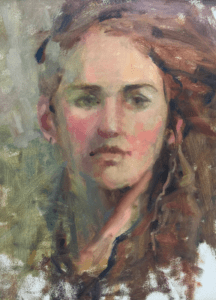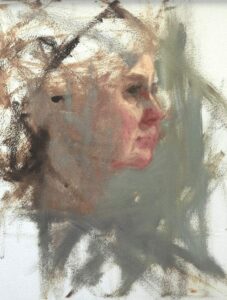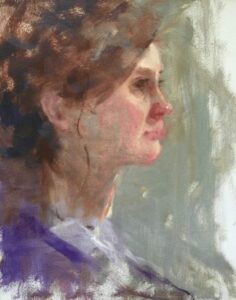
Here’s why I needed to see Carolyn: Stat!
Earlier in the summer, I was excited to join a new group of artists who paint portraits from models every week. Since we met so often, I thought that all this great practice would lead to a freer, more interpretive style in my paintings. Sadly, I was mistaken.

Instead of evolving into a looser style, my portrait studies became more academic, with lots of attention paid to the form of the head and the likeness of my model. But I wanted to evolve! I wanted my portraits to stand alone as pieces of art, rather than something only the model’s family would love.
I knew that I needed to see Carolyn Anderson, and fast. I had gone to one of her workshops a few years ago, and I wanted “Michelle” painted by Ann Feldman before Carolyn’s workshop to reinforce the concepts she taught me about “how to see” and how to integrate the model into a dynamic composition.
Fechin Art Workshops in Taos, New Mexico had an opening in Carolyn’s next workshop. Little did I know how lucky I was to land this spot! The workshop included a room at the beautiful and rustic Hotel St Bernard, nestled in the Taos ski valley, and every day for five days, we painted well into the evenings, with breaks for yoga and meals provided by Jean Mayer, who has hosted visitors to his hotel for over 50 years. Our workshop organizer, Elise Waters Olonia made sure that we could focus all of our attention on our art. I was in heaven!
Here’s what I learned from Carolyn:
The following is a description of a series of demonstrations done by Carolyn for our workshop, condensed into one example. In addition to these demonstrations, Carolyn presented very comprehensive lectures on color theory, edges, temperature, and the art of interpretation, among other topics. To cover all of this information, this article would become the size of a book, so I will focus on what I learned from her demonstrations.

Approach the Composition as a Whole
Carolyn doesn’t paint a model’s head as a separate entity. She looks for the extreme values in the entire setup and makes marks for the darkest darks and the lightest lights and uses these marks to guide the more nuanced values in the rest of the painting.
Find Direction, Movement, and Shapes in the Composition
From her initial value marks, she finds interesting shapes and pathways through the composition to make the painting dynamic. This is not the time to define shapes, but to make visual connections that are interesting. She explained that since our eyes pick up value and movement first, we need to use this information throughout the painting process, but most importantly in the very beginning.

Look for Color and Nuance
As she makes her value notes and begins to find directional movement, she also notices color nuance beginning to emerge, and makes color notes throughout the composition. She loads her brush with a color that she sees, then uses it all over the composition wherever it appears to create color harmony in her painting. She tells us that this also keeps her from painting “things”, and dwelling too long on small parts of the composition. She continually builds the painting as a whole.
Build the Painting
She abbreviates steps instead of overdeveloping any areas of the painting and lets areas with similar value intermingle. She avoids solid outlines, especially around the head. She suggests shapes and allows them to meld into the background or other shapes whenever possible. She looks for visual connections everywhere, and tells us that in paintings, objects are not separate from space; everything is connected. As she paints, her eyes continually jump from one area to the next, making marks of whatever catches her eye. This allows the painting to work as a whole. She reminds us that if we look at any one thing too long, it will lose its context. She tells us that “A successful painting happens when the whole is greater than the sum of its parts”.

My Turn to Try: Applying the Lessons Learned
During the workshop, I began to understand that I needed to paint the entire composition rather than focusing on just the model and adding in the background as an afterthought. I tried to find my values and movement from the beginning of my process.
I also tried my hand at finding color harmony and bouncing it around the painting. I made a conscious effort not to paint the model as a separate entity from the background, but to make her part of the whole of the painting and allow values and edges to meld together.
Push Your Boundaries
“If you want to create a painting which exceeds your previous expectations, you have to be willing to fail. Make mistakes and experiment; it’s the only way to push past your boundaries.”
-Carolyn Anderson
For me, this last point is the most important of all. I’ll go back to my portrait group armed with a new attitude instead of playing it safe and painting as I’ve always done, I’ll push my limits and be comfortable with some failures. This is the only way I’ll make new discoveries.

Day 2 of Carolyn’s Workshop


Marsha Savage says
Love Carolyn’s work, and appreciate the insight into her methods. These thoughts are important to all of us as we start each new painting… keeping the harmony, seeing the whole instead of individual “items.” I will approach my next painting with what you have shared with us… thank you!
Ann Feldman says
Hi Marsha, I’m so happy to know that you found this inspiring. Thanks so much for your feedback!
R. Tomlinson says
Unfortunately we had the opposite experience from Ms. Anderson. She insulted the class as a whole and was convinced we were helpless as artists. I had never had that experience before or since.
Judy Palermo says
Thanks for sharing your experience, it’s a common one many of us are going through!
Ann Feldman says
No matter how many portraits I paint, I never think that I’ve learned enough. I don’t think there will ever come a day when I say, OK I think I’ve got this portrait thing figured out. Thanks for commenting Judy!
Gloria J Zucaro says
A well written article with a clear description of how to perceive what we see in it’s entireity.
Ann Feldman says
Thank you Gloria– I hope to see some portraits from you in the future!
Fran Hollander says
Excellent article. I took a workshop from Carolyn several years ago and also feel a need for a refresher, so am signed up to take another workshop from her next April. Can’t wait!
Ann Feldman says
It’s great that you’ll have a chance to take another workshop from Carolyn. She shares so much information with us that it’s helpful to let it all settle in, then reintroduce it again later. The second time around, the concepts weren’t brand new so I tried to push myself even further than the first time I worked with her. Have a wonderful time!
Pam Newell says
I’ve not taken Carolyn’s workshops but have watched the transformation to better artwork of at least 10 of my artist friends who have had her instruction. The feedback I’ve heard about the content of her instruction is impressive. Plus I’ve heard Carolyn speak many times about the creative process. I have put a workshop with Carolyn on my “A” list, and I have worked with some of the very best. I find it’s usually uncomfortable to be in a workshop and try new things outside my normal process, so I was excited to read Ann’s article to learn of her experience. Looks like with Carolyn’s input Ann has taken her art to an even higher level. Kudos to you Ann! You are a very fine painter!
Ann Feldman says
Hi Pam, thanks so much for your comments. I know that you would really enjoy pushing your boundaries with Carolyn. And you’re right– it’s not always the most comfortable experience when we’re in it, but that’s how we know we’re growing as artists, right?
Sherri Burritt says
Ann, I found you article really encouraging. I’ve followed your work for many years and you are an amazing painter and instructor. I see Carolyn’s influence in your work. You are so fortunate to have taken 2 classes. She is tops on my list of workshops. I’ve seen her work and been to events which she has spoken. She views painting at a higher level! Thanks for the review.
Ann Feldman says
Thank you for posting, Sherri. I know that you would really enjoy working with Carolyn, and I’d love to hear about your experience learning from her. Every now and then, I see an artist’s work and I think, I have to see how that artist creates those amazing paintings. Carolyn’s work always speaks to me.
Flo Gaffney says
Ann, Loved your article on Carolyn Anderson. I took a workshop from her several years ago and found your article to be spot on. I feel Carolyn is an excellent instructor who shares information and encourages her students to push themselves forward. I hope to take from her again in the near future. I really can see Carolyn’s influence in your work and it is wonderful. Thank you for sharing your experiences.
Ann Feldman says
I’m so glad you enjoyed it Flo, thank you!
Barbara English says
Thank you for your clear explanation of Carolyn Anderson’s process. I have looked at and admired examples of her work and have always wondered how she accomplished such integrated and compelling portraits. The idea of mark making with a focus on value to begin and then noticing movement and color all over, rather than focusing on specific lines that separate the parts, now allows me to better understand how her approach integrates the various parts into one cohesive whole. Your explanation makes the process much easier to imagine. I also enjoyed your description of your stay there. Now I want to go!
M. Froste says
Actually I like the before workshop portrait better. It looks more real. I think we are used to viewing so many faces that have been enhanced, either by facelift or through Photoshop. It looked refreshingly original and not a copy of someone else’s work.
Is it possible that we know more than we think we do?
Ann Feldman says
Thank you M., I appreciate that. I find myself painting portraits in different levels of looseness, depending on my mood and the model. I’m happy to have the exposure to Carolyn’s technique so I can dip into a more impressionistic style when I’m feeling more “interpretive”! Thanks again for your comment.
John Carston says
I never knew that more practice could help you have an interpretive style. My father mentioned to us a couple of days ago that he wants to buy Taos inn oil paintings that he would add to his contemporary realism collection, and he asked if I had any idea what would be the best option to consider. Thanks to this instructive article, I’ll be sure to tell him that we can consult fine art and dealers as they can answer all our inquiries.